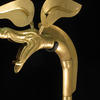"The lost sound - Il suono perduto"
The Karnyx: the Celtic trumpet found in Sanzeno regains its sound and documentary film recounts its story.
The presentation of the documentary film “The lost sound - Il suono perduto” - shot by Decima Rosa, direction by Elena Alessia Negriolli, scientific coordination by the Archaeological heritage office (Cultural Heritage Directorate of the Autonomous Province of Trento) in collaboration with Trentino Film Commission (45 min.) will take place on 24 July at 21 at the cinema “Dolomiti” in Lavarone. After that, Teacher Ivano Ascari of the “F. A. Bonporti” Conservatory of Trento will play the brass replica of the Karnyx of Sanzeno made by silversmith Alessandro Ervas. Finally, Rosa Roncador e Paolo Bellintani, scientific coordinators of the project, will answer the questions of the audience.
Locandina_karnyx_.pdf 4,43 MB
This documentary film will recount the researchers’ difficulties and the satisfactions related to this curious Celtic war trumpet, as further examined here below:
The Celtic musical instrument found in Sanzeno in Val di Non offers a starting point for a cultural reflection. In fact it implies an interaction between ancient peoples - the Celts and the Raeti -, between modern scholars - Italian and French involved in the “karnyx project” - and finally among different disciplines. As a matter of fact, this 2000-year-old bronze musical instrument – i.e. its brass replica – will be the focus around which archeology, chemistry, music and linguistics will cooperate. The Celts, known in ancient times to be formidable warriors, adopted unusual and quaint fighting techniques: among them, they also used special trumpets called karnykes, ending in an animal’s head. The harsh sound they produced was accompanied by the cries of the warriors and the noise of chariots - as Greek historian Polibio recounts - thus creating such a frightening atmosphere, which served as a real psychological weapon. The archaeological evidence relating to these “musical” instruments is very rare: as a result of the current state of research, about twenty karnykes are known today, mostly in a fragmentary state; they were found in France, Switzerland, Germany, Romania and Italy.
The archaeological find of Sanzeno is the one in Italy to be more similar to the other European artifacts. During the excavations of the fifties, Professor Giulia Fogolari unearthed some tubes and a bronze foil whose function has remained unknown for almost sixty years. The discovery made in France at Tintignac archaeological site some years ago, enabled those fragments to be identified in 2012 as coming from a karnyx. The presence of a relic of this kind in the Alps refers to the complex relationships between the Raeti and the Celts, which have been recently studied in a new light. To better understand the purpose and use of this instrument, France and Italy have seen the birth of two groups that deal with the study of Celtic trumpets. Though not linked with one another, they have similar purposes, that is to create a copy of the instrument and to test its sounds and patterns of usage.
In other words, what sounds did they produce? How did they work? And where? Were they used in battle to produce the famous tumultus gallicus? Or did they have a peaceful ceremonial use, as suggested by the locations and contexts (essentially ritual) in which they have been found up to now?
Starting from the analysis carried out at the laboratories of the Louvre, some attempts have been made to understand how craftsmen could create the bronze foils of the karnyx more than two thousand years ago now, and which tools they used, most probably of non-durable materials like wood. It was thanks to silversmith Alessandro Ervas and his experience that a journey into the past could be made in search of ancient techniques for working in bronze which have been lost since long. As a matter of fact, he had achieved knowledge from his family and had conducted experiments for years. The main difficulty he had to cope with was that of shaping those bronze foils above mentioned out of a bronze ingot, thin but resistant. What today is a complex task, was probably daily routine in the past. Along with the artisan’s skills, the experimental reconstruction of the karnyx has needed an important stage in the design process to be shared within the research group in order to create the model. The research group has made reference not only to the fragments found in Sanzeno, but also to other karnykes found in Europe, more precisely in France (Tintignac and Mandeure). The model thus obtained was replicated in brass, also in order to allow the blacksmith to create all the wooden supports necessary for the bronze foils, which are so difficult to forge.
----------------------------------------------------------------------------------------------------------------------------------------
Research group “Karnyx di Sanzeno”: Paolo Bellintani, Rosa Roncador, Elena Silvestri of the Archaeological heritage office - Cultural Heritage Directorate of the Autonomous Province of Trento; Benoit Mille; Centre de Recherche et de Restauration des Musées de France - C2RMF - Paris; Paolo Piccardo; University of Genoa;Ivano Ascari and Roberto Melini; Conservatory “F.A. Bonporti” of Trento; Alessandro Ervas; Fucina Ervas - Preganziol; Elena Negriolli and Aurelio Laino; Decima Rosa – Trento
17/07/2015




